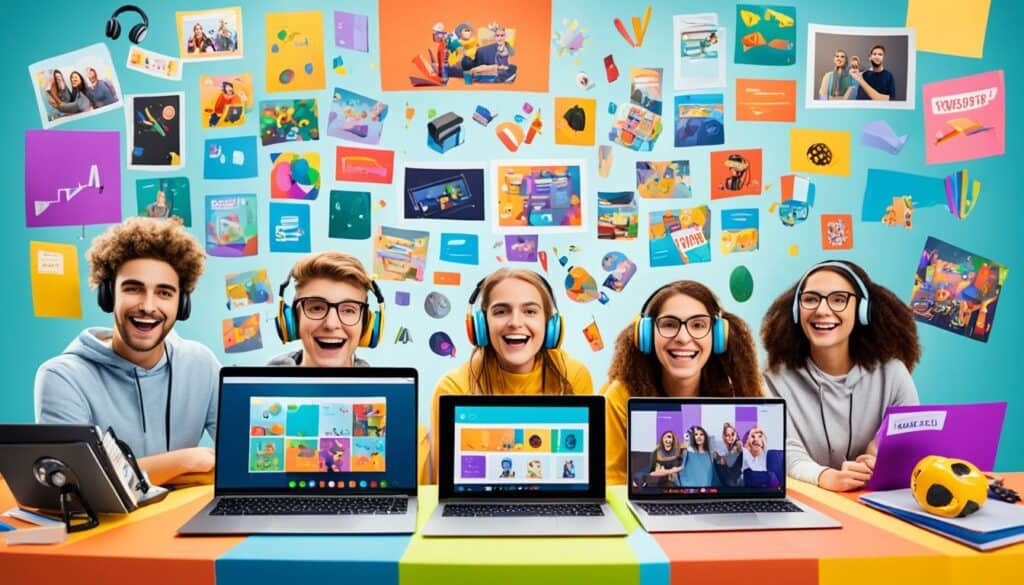Remote learning has become a prominent method of education, especially during the COVID-19 pandemic. It offers benefits such as increased flexibility and affordability. However, it also poses various challenges for students. These challenges include difficulties with time management, asynchronous communication, delayed feedback, unclear expectations, technical issues, feelings of isolation, adapting to new learning styles, distractions in the home environment, and unique challenges for adult learners. Overcoming these challenges is crucial for creating a successful remote learning environment.
Despite its advantages, remote learning presents unique obstacles that students must navigate to succeed. From managing their time effectively to dealing with technical difficulties, students face a range of challenges in online education. In this article, we will explore these challenges and provide strategies for overcoming them.
The Challenge of Time Management in Remote Learning

Remote learning presents unique challenges for students, and one of the most prominent is time management. Effective time management plays a crucial role in academic success and reducing stress levels. However, without the structure of a traditional classroom environment and the support of peers, many students struggle to find a balance between their studies and daily responsibilities.
Research has shown that remote learners often face difficulties in staying focused and setting priorities. The absence of face-to-face interactions and the temptation of distractions in the home environment further exacerbates this challenge. Students must learn to navigate these hurdles and develop effective strategies for managing their time.
- Create a schedule: Establishing a schedule can help remote learners structure their day and allocate time for studying, assignments, and other tasks. Having a routine provides a sense of stability and helps individuals stay on track.
- Prioritize tasks: Setting clear priorities is essential in managing time effectively. By identifying the most important and urgent tasks, remote learners can focus their energy and attention where it matters most.
- Avoid multitasking: While multitasking might seem like an efficient way to accomplish multiple tasks simultaneously, research suggests that it can actually lead to decreased productivity and increased cognitive load. Encourage remote learners to concentrate on one task at a time to optimize their performance.
- Utilize time management tools: Various digital tools and apps are available to assist with time management. These tools can help students track their progress, create to-do lists, set reminders, and manage their time more efficiently.
- Establish a dedicated study space: Having a designated area for studying can help remote learners create a focused environment free from distractions. This space should be organized, comfortable, and conducive to learning.
By overcoming the challenge of time management in remote learning, students can maximize their productivity, reduce stress, and improve their overall academic performance. Implementing effective strategies and utilizing available resources can ensure a successful and fulfilling remote learning experience.
Overcoming Communication Barriers in Remote Learning

Effective communication is vital for successful remote learning. However, the asynchronous nature of online education can create communication barriers, leading to misunderstandings and delays in resolving issues. Students may find it challenging to get prompt answers and clarify points of confusion without instant communication.
To address this challenge, incorporating real-time communication tools is essential. Video conferencing software allows students and teachers to engage in live conversations, fostering immediate interaction and facilitating better understanding. Instant messaging apps enable students to ask questions and receive timely responses, minimizing delays and enhancing communication.
Addressing Delayed Feedback in Remote Learning

One of the challenges of remote learning is the potential for delayed feedback, which can create confusion and uncertainty for students. Timely feedback is crucial for students to understand their progress and make necessary improvements. Fortunately, there are strategies that teachers can implement to address this challenge.
One effective approach is to schedule regular feedback sessions with students. By setting specific times for providing feedback, teachers can ensure that students receive timely information about their performance. This helps students stay on track and make the necessary adjustments to improve their learning outcomes.
In addition to scheduled feedback sessions, teachers can also provide verbal feedback to save time. Instead of relying solely on written feedback, which may take longer to provide, incorporating verbal feedback during virtual class discussions or one-on-one meetings allows for immediate clarification and guidance for students.
By actively addressing the issue of delayed feedback in remote learning, teachers create a more supportive and engaging learning environment. Students can better understand their progress and performance, leading to improved learning outcomes.
Setting Clear Expectations in Remote Learning

Clear expectations play a crucial role in remote learning as they help students understand their tasks and projects. However, the asynchronous nature of communication in online education can make it challenging to establish and maintain clarity in standards.
One way teachers can overcome this challenge is by providing comprehensive guidelines and tutorials on using online learning platforms and digital tools. These resources act as valuable references, ensuring that students have a clear understanding of how to navigate the virtual classroom environment and access learning materials.
By offering clear instructions and expectations, educators can contribute to a more effective remote learning experience. Students can confidently engage in their studies, knowing exactly what is expected of them and how to meet those expectations.
Ensuring clear expectations is especially important for remote learners as they don’t have the immediate face-to-face guidance that traditional classrooms offer. Comprehensive guidelines and tutorials serve as a bridge, providing remote students with the necessary support and resources to succeed in their online education journey.
Advantages of Setting Clear Expectations
- Increased student understanding: Clear expectations help students grasp the objectives and requirements of their assignments, projects, and assessments.
- Improved time management: When students have a clear understanding of expectations, they can better allocate their time and prioritize their tasks, leading to enhanced time management skills.
- Reduced confusion and anxiety: Well-defined expectations minimize confusion and anxiety among remote learners, enabling them to approach their studies with confidence.
- Foster independence: Clear guidelines allow students to work independently and take ownership of their learning, developing valuable self-directed study skills.
- Enhanced academic performance: When students know what is expected of them, they can align their efforts accordingly, leading to improved academic performance.
In summary, remote learning thrives when clear expectations are established. By providing students with comprehensive guidelines and tutorials, educators can empower and guide remote learners towards success in their online education journey.
Tackling Technical Issues in Remote Learning

Technical issues can pose significant challenges to the effectiveness of online learning. Inadequate access to technology and unreliable internet connectivity are common problems faced by many students in remote education. These technical issues can disrupt the learning process, causing frustration and disengagement.
To ensure a smooth remote learning experience, institutions and educators must prioritize addressing technical problems. Students should have access to necessary technological resources, such as laptops, reliable internet connections, and software platforms. Additionally, educators should provide readily available technical support to assist students in resolving any issues they may encounter.
Steps to Overcome Technical Challenges in Remote Learning:
- Conduct a technology needs assessment to identify potential issues and provide support accordingly.
- Offer resources and tutorials to help students navigate online platforms and troubleshoot common technical problems.
- Encourage students to have alternative internet access options, such as mobile hotspots or public Wi-Fi, in case of connectivity issues at home.
- Promote digital literacy by providing training and guidance on utilizing online tools effectively.
- Collaborate with IT departments and support staff to streamline technology-related processes and ensure a smooth remote learning experience.
By addressing technical challenges in remote learning, institutions and educators can help students overcome barriers to online education and create a more conducive virtual learning environment.
Combating Feelings of Isolation in Remote Learning

The transition to remote learning can often lead to feelings of isolation among students. The absence of physical presence in a virtual classroom setting and the lack of face-to-face interaction with peers and instructors diminishes the sense of community and support found in traditional educational settings.
To address this challenge, educators can implement strategies that foster social interaction and create a sense of belonging for remote learners. Virtual study groups provide an opportunity for students to connect with their peers, collaborate on assignments, and engage in meaningful discussions.
Online discussion boards serve as a platform for students to share ideas, ask questions, and receive feedback from both their peers and instructors. This virtual space enables students to feel connected and supported, reducing feelings of isolation.
In addition, live video conferencing sessions allow for real-time communication and interaction, simulating the classroom environment. Through these sessions, students can engage in class discussions, ask questions, and receive immediate feedback from their instructors.
By incorporating these strategies, educators can combat feelings of isolation in remote learning, creating a supportive and inclusive virtual learning environment. It is essential to prioritize the mental well-being of students, ensuring they feel connected and engaged throughout their online education journey.
Adapting to New Learning Styles in Remote Learning

Remote learning introduces students to new learning styles that may differ significantly from traditional classroom experiences. This transition can be challenging as students must become proficient in navigating digital platforms and resources. However, educators play a crucial role in facilitating this adaptation process by providing comprehensive guides and tutorials on using online learning platforms and digital tools.
Through these resources, students can familiarize themselves with the different features and functionalities of remote learning platforms. They can learn how to access course materials, participate in online discussions, submit assignments, and communicate with instructors and peers. By mastering these tools, students can effectively engage in online education and optimize their learning experience.
An essential aspect of adapting to new learning styles in remote learning is understanding how to navigate digital resources. Students must learn to find and utilize online libraries, research databases, and other educational websites for conducting research and gathering information. Furthermore, they should develop skills in evaluating the credibility and reliability of online sources, ensuring the quality of their work.
Online education also presents opportunities for students to collaborate with peers virtually. Group projects and online discussions allow students to share ideas, gather feedback, and engage in constructive discussions. Learning how to effectively collaborate in a digital environment is a valuable skill that can enhance remote learning experiences.
To illustrate these concepts, the image below highlights a student engrossed in an online discussion with classmates, reflecting the collaborative nature of remote learning.
By adapting to new learning styles in remote learning, students can navigate the challenges of online education and make the most of their educational opportunities. Educators can play a crucial role in supporting this transition by providing guidance, resources, and ongoing support to ensure students thrive in the digital learning environment.
Minimizing Distractions in the Home Environment in Remote Learning

While remote learning offers the comfort of studying from home, it also introduces a myriad of distractions that can hinder students from maintaining focus. From household chores to the temptation of social media, these distractions can significantly impact the learning experience. To overcome this challenge, students need to implement strategies that minimize distractions and promote a productive study environment.
Creating a Dedicated Study Space
One effective strategy is to set up a dedicated study space within the home environment. This space should be free from distractions, such as noisy areas or high traffic zones. By designating a specific area solely for studying, students can mentally prepare themselves for focused learning and minimize any potential disruptions.
Utilizing Time Management Tools
Another valuable strategy for minimizing distractions is the utilization of time management tools. These tools can help students stay organized, prioritize tasks, and allocate dedicated study time. By implementing calendars, to-do lists, or productivity apps, students can effectively manage their time and reduce the likelihood of succumbing to distractions.
Advice from Educators
Educators play a crucial role in supporting students to overcome distractions in the home environment. They can provide valuable advice on creating an effective learning environment, including suggestions on setting up study spaces and establishing routines. Educators can also encourage students to take regular breaks, as short intervals of relaxation can enhance focus and productivity when returning to their studies.
By implementing these strategies and seeking guidance from educators, students can minimize distractions in the home environment and create a conducive setting for remote learning success.
Unique Challenges for Adult Learners in Remote Learning

Adult learners face distinct challenges when participating in remote learning. Balancing work, family responsibilities, and education requires exceptional time management and organizational skills. Additionally, returning to an educational setting after a prolonged absence from formal learning environments presents additional hurdles.
For adults, managing competing priorities and finding dedicated study time can be difficult. They often need to juggle work responsibilities, family commitments, and personal obligations, making it crucial to create a structured schedule that allows for focused learning.
Furthermore, adapting to the online learning format can be challenging for adult learners who are accustomed to traditional classroom settings. They may need to develop new technological skills and familiarize themselves with different digital platforms and tools.
Educators play a vital role in supporting adult learners during their remote learning journey by providing tailored guidance and support. Offering resources on effective time management, assisting with technology-related issues, and delivering targeted instruction can help adult learners overcome these challenges and succeed in their educational endeavors.
Finding Balance Between Work, Family, and Education
Adult learners often have multiple responsibilities, including full-time jobs and familial obligations. They must strike a balance between their work, family responsibilities, and educational pursuits to succeed in remote learning.
- Implementing effective time management strategies
- Creating a schedule that includes dedicated study time
- Communicating openly with employers and family members about educational commitments
- Seeking support from family and friends to alleviate some non-academic responsibilities
By establishing a balanced routine and effectively communicating their commitments, adult learners can fulfill their responsibilities while making progress in their remote education.
Adapting to Online Learning Environments
Transitioning from a traditional classroom to an online learning environment poses a learning curve for adult learners. They may face challenges in navigating digital platforms, utilizing online resources, and effectively engaging with remote instructional methods.
- Providing comprehensive training on online learning platforms and tools
- Offering guidance on effective digital learning strategies
- Supporting adult learners in becoming familiar with online educational resources
- Encouraging active participation in virtual discussions and collaborative activities
Assisting adult learners in adapting to the online learning environment enhances their comfort and confidence in utilizing technology for educational purposes.
Ensuring Meaningful Engagement and Motivation
Remote learning can sometimes create a sense of isolation for adult learners due to the lack of face-to-face interaction with classmates and instructors. Encouraging meaningful engagement and motivation is crucial to maintaining their enthusiasm and commitment to the learning process.
- Facilitating virtual study groups to foster collaboration and peer support
- Implementing interactive learning activities that promote active participation
- Organizing live video conferencing sessions for real-time discussions and Q&A
- Providing regular feedback and support to keep adult learners motivated
By fostering a sense of community and creating opportunities for interaction, adult learners can feel connected and motivated to persist in their remote learning journey.
Importance of Effective Time Management in Remote Learning

Effective time management is essential for remote learners to achieve success in their educational journey. As students navigate the challenges of remote learning, developing strong time management strategies becomes crucial for optimizing productivity and balancing various responsibilities.
One effective way to support students in managing their time efficiently is by encouraging them to utilize time management apps and resources. These tools can help students prioritize tasks, set realistic goals, and create schedules that align with their unique needs and preferences.
Implementing surveys to gather insights into students’ time allocation can also provide valuable information on areas for improvement. By understanding how students are spending their time, educators can offer personalized guidance and support to help them better allocate their time for maximum productivity.
By emphasizing the importance of effective time management, students can develop habits that enable them to find a balance between their studies and other responsibilities. They can allocate specific time slots for focused learning, enhance their productivity, and reduce procrastination.
Moreover, effective time management allows students to create structured routines that foster a sense of control and stability in the remote learning environment. Students who effectively manage their time are better equipped to meet deadlines, complete assignments, and actively engage in virtual discussions and activities.
By empowering students with the necessary time management skills, educators set them on a path to remote learning success. Students who effectively manage their time not only have the opportunity to excel academically but also experience reduced stress levels and improved overall well-being.
To sum up, effective time management is a critical aspect of remote learning. By encouraging the use of time management tools, conducting surveys to assess time allocation, and providing personalized guidance, educators can empower students to optimize their time and achieve success in their remote learning journey.
Addressing Technological Challenges in Remote Learning
Institutions offering remote learning must address the technological challenges that students may face. One of the crucial aspects is providing robust technical support to ensure a smooth online learning experience. Institutions should have a dedicated technical support team available to assist students in resolving any technical issues they encounter. This support can range from troubleshooting connectivity problems to assisting with software and platform navigation.
In addition to technical support, reliable internet connections are essential for remote learning. Institutions should ensure that students have access to stable internet connections to minimize disruptions during virtual classes and learning activities.
To enhance students’ ability to navigate online platforms and tools effectively, institutions should also provide digital literacy training. This training can help students develop the necessary skills to navigate learning management systems, utilize collaborative tools, and troubleshoot basic technical problems independently.
Another important consideration is making learning platforms accessible on mobile devices. As many students rely on smartphones and tablets for accessing online content, ensuring mobile compatibility increases flexibility and adaptability for remote learners.
By addressing these technological challenges through technical support, reliable internet connections, digital literacy training, and mobile accessibility, institutions can optimize the remote learning experience and empower students to succeed in remote learning environments.
Fostering Community and Social Interaction in Remote Learning

Educators play a crucial role in fostering a sense of community and promoting social interaction in remote learning environments. By creating opportunities for students to engage with their peers and instructors, feelings of isolation commonly associated with remote learning can be diminished. This sense of community not only enhances the learning experience but also promotes student engagement and motivation.
One effective way to foster community in remote learning is by organizing virtual study groups. These groups provide students with a platform to collaborate, discuss course material, and support each other’s learning journey. Additionally, online discussion boards enable students to connect, share ideas, and engage in meaningful conversations outside of the traditional classroom setting.
Live video conferencing sessions present another avenue for social interaction in remote learning. These sessions allow students to interact with their instructors in real time, ask questions, and participate in dynamic discussions. The visual and auditory elements of video conferencing create a more immersive learning experience, fostering a sense of connection and support.
Benefits of Fostering Community and Social Interaction
Fostering community and promoting social interaction in remote learning has numerous benefits for students. Firstly, it provides a support network for students, allowing them to form connections and collaborate with their peers. This support network can boost confidence, alleviate feelings of isolation, and enhance overall well-being.
Secondly, social interaction facilitates the exchange of ideas and diverse perspectives. Through discussions and collaborations with their peers, students gain a deeper understanding of course material and develop critical thinking skills. In addition, the shared experiences and perspectives within a community create a rich learning environment that enhances knowledge acquisition.
Lastly, community-building efforts in remote learning foster a sense of belonging. When students feel connected to their classmates and instructors, they are more likely to actively participate in the learning process, ask questions, and seek help when needed. This engagement contributes to better academic outcomes and a more positive educational experience.
By prioritizing community and social interaction in remote learning, educators can provide students with a supportive and engaging environment. The initiatives of virtual study groups, online discussion boards, and live video conferencing sessions foster connection and promote active participation, ultimately enriching the remote learning experience.
Utilizing Real-Time Communication Tools in Remote Learning

One of the key challenges in remote learning is the lack of immediate interaction and communication between students and teachers. However, with the advancement of technology, educators can overcome this obstacle by utilizing real-time communication tools such as video conferencing software and instant messaging apps.
Video conferencing software allows for live conversations, questions, and discussions, creating a more engaging and interactive learning experience. Students can participate in virtual classrooms, where they can see and hear their instructors and peers in real-time. This fosters a sense of connection and community, making the learning process more dynamic and collaborative.
Instant messaging apps, on the other hand, enable students to communicate with their teachers and classmates outside of scheduled class times. This allows for quick clarification of doubts, sharing of resources, and collaborative problem-solving. Students can also engage in group discussions, enabling the exchange of ideas and perspectives even when physically apart.
By leveraging these real-time communication tools, remote learning can mimic the interactive nature of traditional classrooms, enhancing students’ engagement and providing immediate support. Educators can foster meaningful connections, address questions promptly, and promote active participation, ultimately leading to a more enriching and productive remote learning experience.
Enhancing Feedback Mechanisms in Remote Learning

Feedback plays a crucial role in remote learning, allowing students to gauge their progress, understand their strengths and weaknesses, and make necessary improvements. Teachers can enhance feedback mechanisms by implementing strategies that ensure students receive timely and meaningful feedback.
Scheduling regular feedback sessions is an effective way to provide consistent guidance and support to students. These sessions can be conducted through video conferencing platforms or online collaboration tools, allowing for real-time discussions and personalized feedback.
Additionally, providing verbal feedback can further enhance the remote learning experience. Teachers can offer verbal comments and explanations during video meetings or through audio recordings, addressing students’ questions and concerns directly.
By offering constructive feedback, teachers can help students clarify expectations, identify areas for improvement, and gain a deeper understanding of the course materials. Clear and actionable feedback fosters continuous learning and motivates students to excel in their studies.
Embracing Strategies for Successful Remote Learning
Optimizing the educational experience in remote learning requires the implementation of effective strategies. By establishing a routine, students can create structure and consistency in their daily lives, helping them stay focused and motivated. Prioritizing communication is crucial, as regular interaction with teachers and peers ensures a sense of connection and support, minimizing feelings of isolation. Additionally, addressing technological challenges through reliable internet access and digital literacy training enables seamless participation in online classes.
Encouraging engagement is essential to promote active learning. Teachers can incorporate interactive activities, group discussions, and virtual collaboration to enhance student involvement. Managing distractions in the home environment is equally vital. By designating a dedicated study space and using time management techniques, students can minimize interruptions and maintain concentration on their coursework.
Furthermore, utilizing support services such as academic resources, counseling, and technical assistance can provide valuable guidance and assistance throughout the remote learning journey. By embracing these strategies, both students and teachers can overcome the challenges of remote learning and create a successful and rewarding online education experience.
 Fullersears
Fullersears





